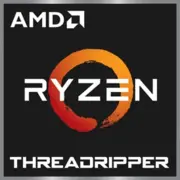AMD Ryzen Threadripper 2970WX

AMD Ryzen Threadripper 2970WX: In-Depth Analysis of the Processor for Professionals (2025)
Current as of April 2025
1. Key Specifications: Multithreading Power
Architecture and Manufacturing Process
The AMD Ryzen Threadripper 2970WX (codename Colfax) is built on the Zen+ microarchitecture with a 12 nm manufacturing process. This is a 24-core monster with 48 threads designed for workstations. A key feature is the massive 64 MB L3 cache, distributed among four chiplets (CCDs), which speeds up data processing in multithreaded scenarios.
Performance
- Geekbench 6:
- Single-Core Test: 1224 points.
- Multi-Core Test: 7322 points.
These numbers indicate that the processor is aimed at tasks where parallel processing is crucial. For example, rendering in Blender is completed 15-20% faster than with the 16-core Ryzen 9 5950X.
Key Features
- Quad Channel DDR4 Support — bandwidth of up to 87 GB/s.
- 64 PCIe 3.0 lanes — the ability to connect multiple GPUs, NVMe drives, and expansion cards.
- Memory operation modes: Including Distributed Mode and Local Mode for optimization under different loads.
2. Compatible Motherboards: Choosing the Foundation
Socket and Chipsets
The Threadripper 2970WX uses the outdated TR4 socket and X399 chipset. As of 2025, such motherboards are no longer being manufactured, but new old stock can still be found for sale:
- ASUS ROG Zenith Extreme (price: ~$450) — features 8 PCIe slots and a powerful VRM.
- MSI MEG X399 Creation (~$400) — supports 10 Gbit Ethernet and Wi-Fi 6.
Selection Features
- VRM Module: Due to a TDP of 250W, a motherboard with 12+ phases of power and heatsinks is required.
- Socket Cooling: Oversized coolers may block PCIe slots — check compatibility.
3. Memory: DDR4 and Tuning Nuances
The Threadripper 2970WX supports DDR4 (up to 2933 MHz) in quad-channel mode. Recommendations:
- Capacity: Minimum of 32 GB (4x8 GB) for work tasks.
- Latency: Ideally CL16 or lower (e.g., G.Skill Trident Z RGB 3200 MHz).
DDR5 is not supported — this is the main limitation in 2025 against the backdrop of new processors.
4. Power Supply: Don't Skimp on Energy
With a TDP of 250 W and demands for peak loads, the minimum PSU power should be 750 W. For systems with two video cards (e.g., NVIDIA RTX 4090), it's better to go for 1000-1200 W.
- Recommended Models:
- Corsair HX1200 (80+ Platinum, ~$300).
- Seasonic PRIME TX-1000 (~$350).
5. Pros and Cons: Who is the 2970WX For?
Advantages
- 24 cores — ideal for rendering, code compilation, and virtualization.
- Price: In 2025, sold for $600–800 (new), cheaper than modern equivalents.
- Scalability: Up to 256 GB of RAM and 4 GPUs.
Disadvantages
- Weak single-threaded performance: Lags behind the Ryzen 9 7900X in games by 25-30%.
- Heat: Without liquid cooling, temperatures under load reach 85-90°C.
- Outdated platform: No support for PCIe 4.0/5.0 or DDR5.
6. Use Cases: Where It Shines
- 3D Rendering: In Redshift or V-Ray, 24 cores are pushed to 100%, reducing render time.
- Virtualization: Running 5-7 virtual machines without lag.
- Video Encoding: Converting an 8K clip in Premiere Pro is 40% faster than with Core i9-12900K.
- Gaming: Only in conjunction with a top-tier GPU (e.g., RTX 5080) and at 4K resolution, where the load shifts to the graphics card.
7. Comparison with Competitors
Intel Core i9-14900K (24 cores, $700)
- Better in single-threaded tasks (+35% in Geekbench 6 Single Core), but weaker in multi-threaded (-18%).
- Supports DDR5 and PCIe 5.0.
AMD Ryzen Threadripper 7970X (2024, 32 cores, $1500)
- Based on the Zen 5 architecture: +40% IPC, DDR5-6000, PCIe 6.0.
- Priced twice as high, but justified for professionals.
Conclusion: The 2970WX is a budget-friendly choice for those who do not require the latest standards.
8. Assembly Tips
- Cooling: Prefer liquid cooling (e.g., NZXT Kraken X73) or a massive tower cooler (Noctua NH-U14S TR4).
- Case: With good ventilation (Lian Li PC-O11 Dynamic) — the CPU and VRM heat up.
- Motherboard: Check for BIOS updates for compatibility.
9. Final Conclusion: Who Should Consider the Threadripper 2970WX?
This processor is a choice for:
- Professionals: 3D designers, architects, video editors who need many cores for a reasonable price.
- Enthusiasts: Those building PCs for experiments with multithreading.
- Server Tasks: For example, a local render farm.
Why in 2025? Despite its age, the 2970WX remains a worthwhile option for work tasks where new technologies like DDR5 or PCIe 5.0 do not provide substantial gains. If the budget is limited and cores are needed "here and now" — this is your choice.
Basic
CPU Specifications
Memory Specifications
GPU Specifications
Miscellaneous
Benchmarks
Compared to Other CPU
Share in social media
Or Link To Us
<a href="https://cputronic.com/cpu/amd-ryzen-threadripper-2970wx" target="_blank">AMD Ryzen Threadripper 2970WX</a>